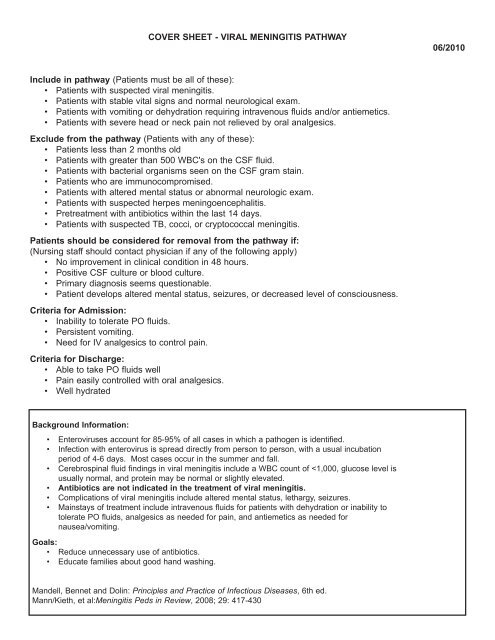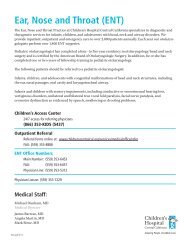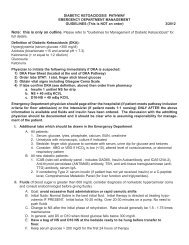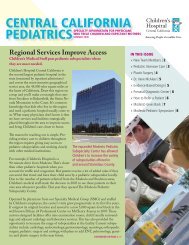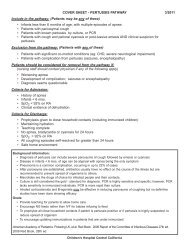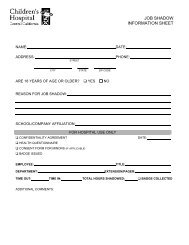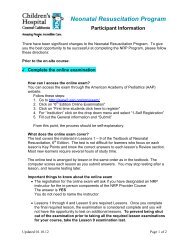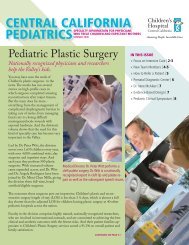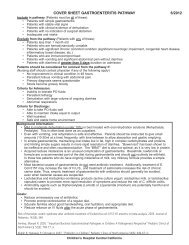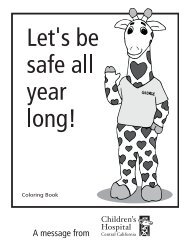Viral Meningitis Pathway - Children's Hospital Central California
Viral Meningitis Pathway - Children's Hospital Central California
Viral Meningitis Pathway - Children's Hospital Central California
- No tags were found...
Create successful ePaper yourself
Turn your PDF publications into a flip-book with our unique Google optimized e-Paper software.
COVER SHEET - VIRAL MENINGITIS PATHWAY<br />
06/2010<br />
Include in pathway (Patients must be all of these):<br />
• Patients with suspected viral meningitis.<br />
• Patients with stable vital signs and normal neurological exam.<br />
• Patients with vomiting or dehydration requiring intravenous fluids and/or antiemetics.<br />
• Patients with severe head or neck pain not relieved by oral analgesics.<br />
Exclude from the pathway (Patients with any of these):<br />
• Patients less than 2 months old<br />
• Patients with greater than 500 WBC's on the CSF fluid.<br />
• Patients with bacterial organisms seen on the CSF gram stain.<br />
• Patients who are immunocompromised.<br />
• Patients with altered mental status or abnormal neurologic exam.<br />
• Patients with suspected herpes meningoencephalitis.<br />
• Pretreatment with antibiotics within the last 14 days.<br />
• Patients with suspected TB, cocci, or cryptococcal meningitis.<br />
Patients should be considered for removal from the pathway if:<br />
(Nursing staff should contact physician if any of the following apply)<br />
• No improvement in clinical condition in 48 hours.<br />
• Positive CSF culture or blood culture.<br />
• Primary diagnosis seems questionable.<br />
• Patient develops altered mental status, seizures, or decreased level of consciousness.<br />
Criteria for Admission:<br />
• Inability to tolerate PO fluids.<br />
• Persistent vomiting.<br />
• Need for IV analgesics to control pain.<br />
Criteria for Discharge:<br />
• Able to take PO fluids well<br />
• Pain easily controlled with oral analgesics.<br />
• Well hydrated<br />
Background Information:<br />
• Enteroviruses account for 85-95% of all cases in which a pathogen is identified.<br />
• Infection with enterovirus is spread directly from person to person, with a usual incubation<br />
period of 4-6 days. Most cases occur in the summer and fall.<br />
• Cerebrospinal fluid findings in viral meningitis include a WBC count of
Time/<br />
Date:<br />
General<br />
1) Diagnosis: <strong>Viral</strong> <strong>Meningitis</strong><br />
2) Estimated length of stay = 1-2 days<br />
3) Condition: Stable<br />
4) Vitals (including BP), neurological checks and pain assessment every 6 hrs and PRN for pain<br />
5) Activity: As tolerated for age<br />
6) Contact precautions<br />
7) Accurate I's & O's (every 4 hrs to determine PO intake and output)<br />
8) Daily weights<br />
9) Initiate "Learning Assessment" and implement viral meningitis education<br />
10) On admit, assess discharge needs and make appropriate referrals (see pediatric<br />
admission database)<br />
11) Notify physician of any mental status changes or seizures<br />
Education:<br />
1) BEGIN EDUCATION AT ADMISSION<br />
2) Review viral meningitis "Patient Education Sheet" with family<br />
• Teach signs of dehydration, signs of inadequate PO intake<br />
• Review who to contact for problems and reasons to call physician or return to ER<br />
• Emphasize good hand washing techniques<br />
Diet & Fluids<br />
Weight:<br />
Allergies:<br />
1) Diet<br />
• If patient has nausea and/or vomiting start with a clear liquid diet and advance as<br />
tolerated to regular diet for age.<br />
• If patient is without nausea/vomiting start regular diet as tolerated.<br />
Fluids<br />
ORAL FLUIDS ARE THE PREFERRED SOURCE OF HYDRATION.<br />
ALWAYS ATTEMPT ORAL FLUIDS FIRST.<br />
1) If patient is vomiting or unable to tolerate PO fluids start maintenance fluids.<br />
Maintenance Fluids (PO plus IV)<br />
0-10 Kg 4 mL/kg/hr<br />
11-20 Kg 40 mL/hr + (2 mL/kg/hr for each kg > 10)<br />
>20 Kg 60 mL/hr + (1 mL/kg/hr for each kg > 20)<br />
Physician’s Signature/ID Number: ___________________________________________________ Date: ____/____/____ Time: _________________<br />
page 1 of<br />
<strong>Viral</strong> <strong>Meningitis</strong><br />
2 Patient Label<br />
0032<br />
*0032*<br />
pathway 06/2010<br />
Choice of IV fluids:<br />
D5 ½ NS + 20 mEq KCI/L<br />
If serum bicarbonate (total CO 2 ) < 15, substitute 20 mEq/L K-Acetate instead of KCI in IV fluids<br />
(nurse to call pharmacy)<br />
If repeat serum bicarbonate (total CO 2 ) > 20, resume use of KCI instead of K-Acetate<br />
(nurse to call pharmacy)<br />
Once patient taking adequate PO's without vomiting - wean IV to saline lock PIV.<br />
Physician’s Order Sheet
Time/<br />
Date:<br />
Diagnostic Tests<br />
• Enterovirus PCR on CSF if not already sent.<br />
• If initial bicarbonate (total CO 2 ) less than 15 on admission repeat BMP 12 hours after<br />
inpatient admission.<br />
• If CO 2 less than 12 or sodium less than 130, notify the physician.<br />
Weight:<br />
Allergies:<br />
Medications<br />
1) Acetaminophen 15 mg/kg (max. dose=650 mg) PO/PR every 4 hrs PRN T > 38.0 C-38.9 C or mild<br />
pain (max. dose= 75 mg/kg/day or 4 gms/day; whichever is less).<br />
• If patient's temperature remains above 38.0 C one hour after administration, then give<br />
Ibuprofen.<br />
2) Ibuprofen 10 mg/kg (max. dose=400 mg) PO every 6 hrs PRN T > 38.9 C or moderate pain.<br />
• If patient's temperature remains above 38.0 C one hour after administration, then give<br />
Acetaminophen.<br />
3) Ondansetron 0.1 mg/kg/dose - (max dose of 4 mg per dose) IV every 8 hours as needed for nausea<br />
or vomiting.<br />
4) Morphine 0.1 mg/kg/dose (max dose of 4 mg) IV every 4 hours as needed for severe pain.<br />
(nurse to contact physician for unrelieved pain)<br />
Follow-up<br />
1) Place preprinted discharge instructions in chart.<br />
2) FAX discharge instructions (once signed by physician) to primary care physician.<br />
Physician’s Signature/ID Number: ___________________________________________________ Date: ____/____/____ Time: _________________<br />
<strong>Viral</strong> <strong>Meningitis</strong><br />
0032<br />
*0032*<br />
pathway 06/2010<br />
Physician’s Order Sheet<br />
page 2 of 2<br />
Patient Label
<strong>Viral</strong> <strong>Meningitis</strong><br />
Education Information for Patients and Families<br />
What is viral meningitis<br />
It is swelling and infection of the meninges. The meninges cover<br />
the brain and spinal cord. Within the meninges is fluid that<br />
cushions and protects the brain and spinal cord. This fluid can<br />
also be infected. The infection is caused by a virus.<br />
How did my child get meningitis<br />
You can get viral meningitis from someone who is infected<br />
with a virus. There are many different types of viruses that can<br />
cause viral meningitis. Ways to spread infection after touching<br />
someone who has a virus:<br />
• sharing drinking glasses or food<br />
• shaking hands<br />
• rubbing your eyes, nose, or mouth<br />
• changing diapers and not washing your hands<br />
meninges<br />
How will I know if my child has meningitis<br />
Not every child or infant will have the same symptoms. Some of the most common symptoms<br />
are:<br />
• fever<br />
• severe headache<br />
• stiff neck<br />
• irritability, crying, difficult to console<br />
• being sensitive to light<br />
• drowsiness, confusion, or change in behavior<br />
• nausea, vomiting<br />
• sleeping more than usual<br />
• poor feeding or refusing to eat<br />
• high-pitched cry, arching back in infants<br />
The symptoms of viral meningitis can be the same as bacterial meningitis. When meningitis is<br />
caused by a virus, it is serious, but rarely causes death. When bacteria causes meningitis it is<br />
very serious and can cause death if not treated with antibiotics right away. If you think your<br />
child has meningitis you should take him or her to the emergency department right away.<br />
What can I do to prevent viral meningitis<br />
If you are around someone who is sick, wash your hands frequently. When a child is ill, do not<br />
allow other siblings to have close face to face contact. After changing diapers or using the<br />
restroom, wash your hands and teach your children to wash their hands. Cough or sneeze into a<br />
tissue when possible. Wash hands after using facial tissues. Discourage sharing of drinking and<br />
eating utensils.<br />
Children’s <strong>Hospital</strong> <strong>Central</strong> <strong>California</strong> • 9300 Valley Children’s Place • Madera CA 93636 • (559) 353-3000<br />
Revised: 10/2008 Review by: 07/2011 Page 1 of 2
What is the treatment for viral meningitis<br />
There is no medicine to treat viral meningitis. Antibiotics will not help viral illnesses. It could<br />
take up to 2 weeks for your child to recover completely. During recovery you may do the<br />
following for your child:<br />
• Encourage rest<br />
• Offer plenty of fluids<br />
• Use medicine to treat fever and headache<br />
• Keep your child's room quiet and calm, keep the lighting down<br />
When should I call the doctor<br />
Call your child's doctor if:<br />
• Symptoms become worse (fever becomes higher, headache or stiff neck worsens,<br />
vomiting, etc.)<br />
• You notice a change in your child's behavior<br />
• Your child has seizure activity (jerking and shaking of the body, arms, or legs)<br />
When should I call 911<br />
Call 911 if your child:<br />
• Makes a grunting noise when breathing<br />
• Turns blue or gray in color<br />
• Passes out<br />
• Stops breathing<br />
START CPR IF NEEDED.<br />
Children’s <strong>Hospital</strong> <strong>Central</strong> <strong>California</strong> • 9300 Valley Children’s Place • Madera CA 93636 • (559) 353-3000<br />
Revised: 10/2008 Review by: 7/2011 Page 2 of 2
Discharge Sheet<br />
Dictation: 1-800-411-1001 (#963)<br />
D/S Job #: ________<br />
For <strong>Hospital</strong> Use Only<br />
Discharge sheet FAXed to PCP _______________<br />
initial/date<br />
Follow-up appointment SCHEDULED with PCP _______________<br />
initial/date<br />
PATIENT’S NAME:_______________________________________________________ DISCHARGE DATE:___________________<br />
Dx:<br />
<strong>Viral</strong> <strong>Meningitis</strong><br />
<strong>Hospital</strong> Course<br />
• Patient admitted with signs/symptoms consistent with viral meningitis<br />
• CSF:<br />
WBC__________ Glucose_____________ Protein____________ CSF culture___________ Enterovirus PCR__________<br />
Complications during hospitalization: ________________________________________________<br />
_________________________________________________________________________________<br />
DISCHARGE CONDITION: ____________________________________________ DISCHARGE WEIGHT: _________<br />
Activity:<br />
Instruction to Patient<br />
Diet: Encourage Fluids<br />
Medications:<br />
See Medication Reconciliation Sheet<br />
Follow Up: _______________________________________________________________________________________<br />
Additional instructions:<br />
Good handwashing. Notify primary care physician or return to emergency department if<br />
fever worsens, headache worsens, change in child’s behavior or seizure activity<br />
Reference: Patient Education Sheet<br />
Signed: ______________________________________ M.D.<br />
____________________________________________<br />
Attending Physician<br />
_________________________________________________<br />
Primary Care Physician<br />
____________________________________________<br />
Signature of Parent or Guardian<br />
_________________________________________<br />
Attending Resident<br />
_____________________________________________<br />
City<br />
<strong>Viral</strong> Mengingitis<br />
Patient Label<br />
0083<br />
*0083*<br />
pathway 06/2010<br />
Discharge Instructions


